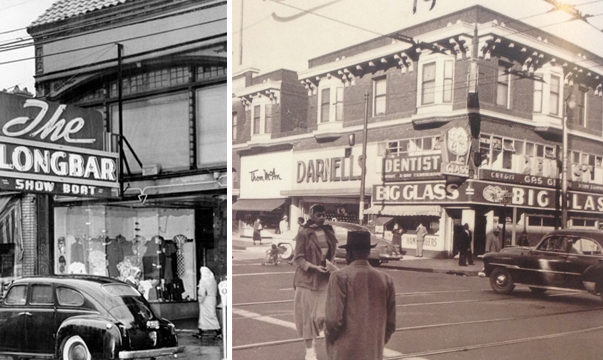
LEFT: Longbar 1952. credit: San Francisco History Center, San Francisco Public Library RIGHT: The Big Glass circa 1958. credit: San Francisco Redevelopment Agency Records
Our timeline of LGBTQ history in San Francisco includes a reference to the Big Glass, which we reported opened in 1964 in the Fillmore to become the City’s first African American LGBTQ bar.
For this, we relied on Gay by the Bay: A History of Queer Culture in the San Francisco Bay Area by Susan Stryker and Jim Van Buskirk, a source used by many others as well. But now new research by Michael Flanagan published in the Bay Area Reporter suggests that this might be wrong, and the Big Glass might be much older and possibly not a gay bar in the modern sense.
Flanagan reports that the Big Glass was owned by Arthur Rosinsky, a Jewish immigrant born in Russia, and his wife Ruth. Neither appear to be LGBTQ nor black. It first opened in 1949 at 1600 Fillmore (at Geary Boulevard) before redevelopment forced it to move to 1801 Fillmore (at Sutter).
Though the bar was not gay-owned, it still may have been popular among LGBTQ patrons. Flanagan’s research uncovered a note to Jose Sarria, a.k.a. the Widow Norton and the first openly-gay candidate for public office in the U.S., recommending that he contact the owners about putting campaign literature in the bar. Sarria ran for a seat on the San Francisco Board of Supervisors in 1961.
Flanagan’s story goes into much more detail about other pre-Stonewall gay bars in the Fillmore neighborhood, including the Gourmet Breakfast Club and Kelly’s Club. The former was closed in 1953 for selling liquor after hours. The latter was closed in 1956 after a police raid for operating a “disorderly house” where the police witnessed “men dancing with men, and women dancing with women” according to a September 22, 1956 article in the San Francisco Chronicle.
It’s well worth reading for a glimpse at this under-reported history. As he wrote, “Many of the bars in the Fillmore may not have been gay bars as we currently understand it, but there was definitely a LGBT presence in the neighborhood.”